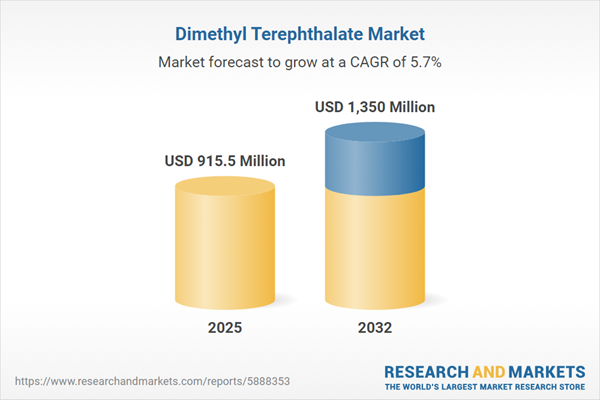Speak directly to the analyst to clarify any post sales queries you may have.
Senior executives in the chemicals sector are navigating heightened complexity in the dimethyl terephthalate market. Disruptive regulatory shifts, sustainability requirements, and rapid innovation are redefining competitive parameters. Anticipating these changes and adapting strategy is essential for organizations seeking to maintain relevance and resilience.
Market Snapshot: Dimethyl Terephthalate Market Outlook
The dimethyl terephthalate market is progressing steadily, with an estimated value of USD 865.95 million forecast for 2024. Projections indicate continued growth, advancing to USD 915.50 million in 2025 and reaching USD 1.35 billion by 2032, supported by a CAGR of 5.70%. This expansion is driven by increasing demand for engineered materials used in manufacturing packaging, textiles, and a broad range of industrial products. Companies are leveraging advanced production technologies, with leaders paying close attention to circular economy models to achieve better resource efficiency and regulatory alignment. These trends demand adaptable business models and proactive stakeholder engagement.
Scope & Segmentation
- End Use Applications: Caters to bottle manufacturers for carbonated drinks and water, supports both industrial production and textile fiber manufacturing, and provides films for biaxial oriented and cast applications serving multiple downstream industries.
- Production Technologies: Utilizes both direct esterification and transesterification, facilitating manufacturing agility and adaptability to meet diverse industry specifications.
- Grades: Offers food grade and technical grade dimethyl terephthalate, aligning with varied industry and regulatory requirements and enabling flexible solutions across differing end uses.
- Purity Levels: Supplies products in multiple purity ranges including 98-99.5%, less than 98%, and above 99.5%, allowing organizations to select quality profiles most compatible with their unique technical criteria.
- Physical Forms: Provides pellets (including micro pellets), powder, and solid formats, enabling efficient logistics and adaptable processing workflows throughout the value chain.
- Geographic Coverage: Maintains a strong position in established markets like the Americas and Europe, while targeting emerging opportunities in the Middle East, Africa, and Asia-Pacific regions including the United States, Germany, China, India, and Australia.
- Company Analysis: Highlights key producers such as Eastman Chemical Company, SK Chemicals Co., Ltd., Nan Ya Plastics Corporation, Asahi Kasei Corporation, DIC Corporation, Zhejiang Juhua Co., Ltd., Changchun Dacheng Chemical Co., Ltd., Jiangsu Verichem Co., Ltd., Shandong Jucheng Chemical Co., Ltd., and Gansu Yangnong Chemical Group Co., Ltd.
Key Takeaways: Strategic Insights for Decision-Makers
- Dimethyl terephthalate underpins polyester-based manufacturing, ensuring organizations maintain material quality and supply chain reliability for demanding applications.
- Strategic investments in production efficiency, including advanced catalyst use and intensified operational methods, can yield both sustainability improvements and increased responsiveness to shifts in demand.
- Growing customer requirements for specialized products, particularly in packaging films and technical fibers, are driving adoption of tailored procurement strategies and service offerings.
- Integrating renewable raw materials and recycling processes is increasingly necessary to meet regulatory and sustainability goals.
- Digital analytics and agile inventory management are now integral for building business resilience and optimizing network efficiency amid volatile conditions.
- Collaboration throughout the value chain is strengthening, as producers and downstream partners work together to deliver compliant and sustainable solutions in diverse regulatory environments.
Tariff Impact: North American Trade Shifts
Recent tariff modifications in the United States are prompting a comprehensive review of supplier networks and sourcing practices. Market players are increasing domestic investments and exploring diversified procurement methods to minimize risk exposure. These regulatory changes are also enhancing engagement with stakeholders, influencing the way organizations allocate capacity and adapt to competitive pressures in the region.
Methodology & Data Sources
The research methodology combines secondary analysis of technical publications, regulatory statements, and global databases with targeted interviews across the supply chain. Site visits, laboratory assessments, scenario analysis, and thorough peer reviews ensure that all findings provide dependable and actionable insight for decision-makers.
Why This Report Matters
- Equips executive teams with the intelligence needed to address the challenges of shifting tariffs, changing regulatory requirements, and ongoing global supply chain developments.
- Delivers targeted strategies for process improvement, digital transformation, and expansion into new segments to support sustainable growth.
- Enables confident decisions in capacity management and value chain organization by supplying rigorously validated market and technical analysis.
Conclusion
Sustained success in the dimethyl terephthalate market requires strategic agility and effective cross-industry partnerships. Executives who stay informed and flexible will be best equipped to anticipate market changes and secure lasting organizational strength.
Additional Product Information:
- Purchase of this report includes 1 year online access with quarterly updates.
- This report can be updated on request. Please contact our Customer Experience team using the Ask a Question widget on our website.
Table of Contents
3. Executive Summary
4. Market Overview
7. Cumulative Impact of Artificial Intelligence 2025
Samples

LOADING...
Companies Mentioned
The key companies profiled in this Dimethyl Terephthalate market report include:- Eastman Chemical Company
- SK Chemicals Co., Ltd.
- Nan Ya Plastics Corporation
- Asahi Kasei Corporation
- DIC Corporation
- Zhejiang Juhua Co., Ltd.
- Changchun Dacheng Chemical Co., Ltd.
- Jiangsu Verichem Co., Ltd.
- Shandong Jucheng Chemical Co., Ltd.
- Gansu Yangnong Chemical Group Co., Ltd.
Table Information
| Report Attribute | Details |
|---|---|
| No. of Pages | 181 |
| Published | October 2025 |
| Forecast Period | 2025 - 2032 |
| Estimated Market Value ( USD | $ 915.5 Million |
| Forecasted Market Value ( USD | $ 1350 Million |
| Compound Annual Growth Rate | 5.7% |
| Regions Covered | Global |
| No. of Companies Mentioned | 11 |









